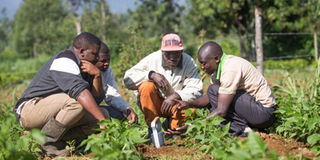Planting season is here, have you tested your soil?

Farmers test their farms' soils in Meru. for reliable results, always sample and test your farm's soil immediately after harvest. PHOTO | CAROLINE WAMBUI | NATION MEDIA GROUP
What you need to know:
- Most farmers are not aware of their soil fertility status despite the fact that the soils are sick. Crops, like all living things, require nutrients and in the right proportion to be healthy.
- Soil test helps farmers understand their soils, deal with the deficiencies and excesses and ensure that the soil nutritional content is correct.
- There are several soil tests, which include testing the soil pH. This checks on the acidity of the soil as the pH is a key factor in plant growth and it affects nutrients availability in plants.
- Soil testing technologies are now advanced and closer to the farmer. According to Ruth, there are portable soil testing technologies and laboratories in various places across the country.
Some farmers are currently planting following the start of the rains, while others are busy preparing their land, but the big question is, do you know the nutritional value of your soil?
Put it in other words, have you done a soil test before you prepare for planting?
Knowledge on soil fertility and soil testing is quite low in East African, according to a recent survey. Out of 1,500 farmers in the region, only 10 per cent have their soils tested.
“Most farmers are not aware of their soil fertility status despite the fact that the soils are sick. Crops, like all living things, require nutrients and in the right proportion to be healthy,” says Ruth Mukhongo, a Senior Soil Scientist at SoilCares Africa.
Soil test, according to Ruth, helps farmers understand their soils, deal with the deficiencies and excesses and ensure that the soil nutritional content is correct.
Haphazard use of fertiliser
But normally when it rains, farmers rush to prepare their land without testing, and later go straight into planting while using a lot of fertiliser, with DAP and CAN being the inputs of choice.
Philip Oketch, an agricultural consultant with Policy and Markets in Meru, notes that the trend of planting ‘blindly’ leads to negative outcomes.
“Continuous use of DAP increases some elements in the soil and decreases others. Different plants require different elements and when an element like iron or phosphorous becomes too much, it affects the growth of another crop like cabbage, maize, carrots or even potatoes and when a farmer uses fertilisers on soils that don’t require it, it translates to excessiveness of certain nutrients leading to low yields.”
There are several soil tests, which include testing the soil pH. This checks on the acidity of the soil as the pH is a key factor in plant growth and it affects nutrients availability in plants.
When pH is maintained at the proper level for a given plant, nutrients are available at the maximum. Most plants prefer a soil pH of between 6.0-7.0 except for tubers like potatoes, which need a more acidic environment.
SAMPLE SOIL IMMEDIATELY AFTER HARVEST
When sampling, a farmer should divide the area to be sampled into different parts, collecting a minimum of 5-10 samples, then combines them and submits for analysis.
One should avoid sampling very wet soils or soils that have been recently fertilised, and samples should be at least 6-8 inches from the ground level. One should avoid areas of high erosion or those close to trees.
The best time of the year to sample is immediately after a harvest. Soil sampling can also be done during the growing season to help in identifying plant growth problems where soils are sampled when symptoms are present to ascertain the problem and take curative action during the current growing season.
The question on how often sampling should be done depends on individual crops where for perennial plants like the trees, testing should be done prior to planting and once every two to three years.
For annuals such as maize or beans, soils should be tested once every two years. For large-scale farmers who regularly use fertiliser, manure or other soil modifications, testing should be done more frequently to monitor changing soil conditions and prevent the build-up of excess levels of nutrients or salts.
Poor knowledge
Farmers should keep all soil tests records for the areas sampled, fertiliser applied and plant yields as this allows them to relate the plant performance in terms of yield to the soil test results and fertilisation practices.
Soil testing technologies are now advanced and closer to the farmer. According to Ruth, there are portable soil testing technologies and laboratories in various places across the country.
However, soil testing has several challenges as some farmers once given the recommendations lack someone to help them interpret the results.
Some extension officers are also not well versed with the technology and cannot interpret the recommendations such as NPK 17:0:17 or 23:23:0 and cannot even help the farmer blend the recommendations.
From her experience, Ruth says most farms across the country are over 76 per cent acidic, meaning the pH levels are too low and farmers are not aware that they can use lime, which goes for about Sh150 per kilo, to reduce the soil acidity.
***
Get the basics
A soil test should analyse the following:
1. The nutritional levels of the soil in terms of nitrogen, phosphorous, potassium, calcium, magnesium, sulphur and iron.
2. Soil pH, that is below 7.0 is acidic, at 7.0 is neutral while above 7.0 has high lime.
3. Organic matter, that is, the nutritional capacity of the soil.
4. The Cation Exchange Capacity. That is the soil’s ability to hold onto essential nutrients and provide a buffer against soil acidification.





